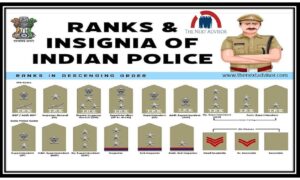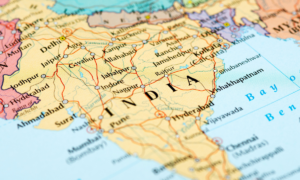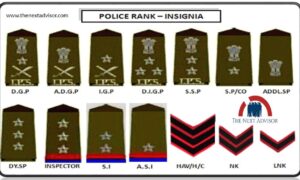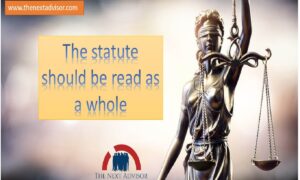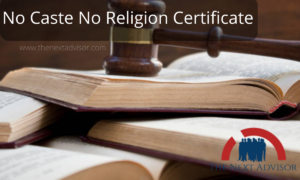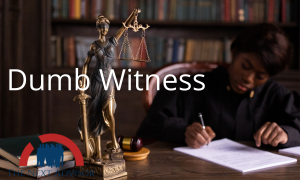History of Indian Constitution is very vast and interesting.
History Of the Indian Constitution:
The Constitution of India was adopted on the 26th of November, in the year 1949, However, it came to effect on the 26th of January, 1950. 26th January is celebrated as the Republic Day of India. In 1928, the All Parties Conference convened a committee in Lucknow to prepare the Constitution of India, which was known as the Nehru Report. Most of colonial India was under British rule from 1857 to 1947.
History of the Indian Constitution
The Constitution was drawn from a number of sources. Mindful of India’s needs and conditions, its frames borrowed features of previous legislation such as the Government of India Act, 1858, the Indian Councils Acts of 1861, 1892, and 1909, the Government of India Acts, 1919 and 1935, and the Indian Independence Act, 1947, the Constitution of India repealed the Indian Independence Act, 1947 and became effective on 26th January 1950.
Drafting Committee: The Constitution was drafted by the Constituent Assembly, which was elected by elected members of provincial assemblies. The 389 members assembly (was reduced to 299 after the partition of India ). Dr. B.R. Ambedkar was a wise constitutional expert, he had studied the constitution of about 60 countries. Ambedkar is recognized as the ” Father of the Constitution of India “.
Structure :
The Indian Constitution is the world’s largest sovereign nation. At its enactment, it had 395 articles in 22 parts and 8 schedules. At about 1,45,000 words, it is the second-longest active constitution ( after the constitution of Alabama ) in the world.
The Constitution has a preamble and 470 articles, which are grouped into 25 parts, with 12 schedules and five appendices, it has been amended 104 times, and the latest amendment became effective on 25 January 2020.
The document lays down the framework that democrats’ fundamental political code, structure, procedures, powers, and duties of government institutions and sets out fundamental rights, directive principles, and the duties of citizens.
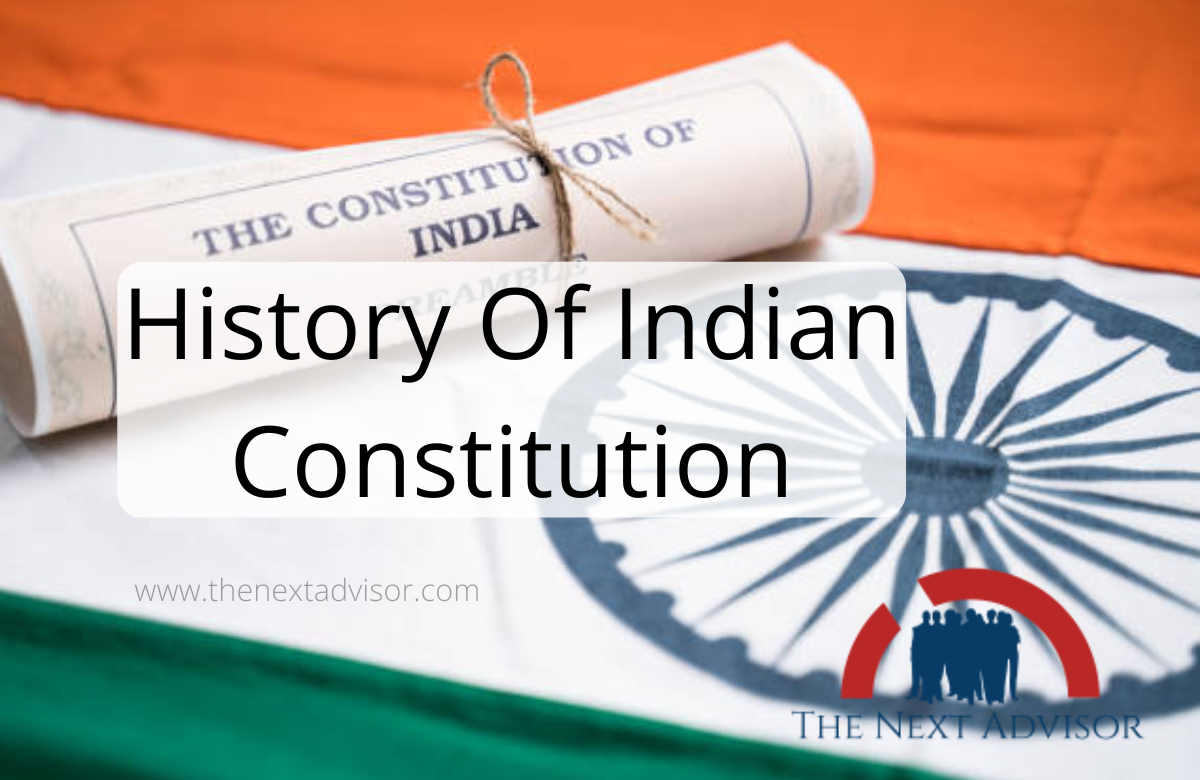
History Of the Indian Constitution
History of the Indian Constitution More Deeply
COMPANY RULE ( 1773-1858 ) REGULATING ACT OF 1773
• Governor General post created.
• Warren Hastings – first governor-general of Bengal
• It is provided for the establishment of the Supreme Court at Calcutta ( 1774 ) comprising one chief justice and three other judges.
• 1st chief justice was Sir Elijah Impey ( 1774-1983 ).
PITTS INDIA ACT – 1784
• Named after the British Prime Minister William Pitt.
• A dual system of control: It created a Board of Control to manage the political affairs of India and limited the responsibilities of the Court of Directors to commercial affairs.
THE CHARTER ACT OF 1813
• This act is also known as The East India Company Act 1813.
• Charter act of 1813 ended the monopoly in the trade of the East India Company in India except for trade in tea with china & India.
THE CHARTER ACT OF 1833
Monopoly in trade with china & trade with India was ended.
It made the Governor-General of Bengal the Governor-General of India
Lord William Bentick was the first governor-general of India.
As per the act, an Indian law commission was established.
The first Law Commission had Lord Macaulay as its chairman.
It sought to codify all Indian law.
THE CHARTER ACT OF 1853
• it established a separate Governor-General’s legislative council which came to be known as the Indian ( Central ) Legislative Council. This legislative wing of the council functioned as a mini – Parliament, adopting the same procedures as the British Parliament.
• It introduced, for the first time, local representation in the Indian ( Central ) Legislative Council. Of the six new legislative members of the governor general’s council, four members were appointed by the local ( provincial ) governments of Madras, Bombay, Bengal, and Agra.
Civil services were thrown open to Indians.
CROWN RULE ( 1858-1947 ) GOVERNMENT OF INDIA ACT 1858
• It changed the designation of the Governor – General of India to that of Viceroy of India.
• Lord Canning thus became the first Viceroy of India.
• It ended the system of double government by abolishing the Board of Control and Court of Directors.
INDIAN COUNCILS ACT OF 1861.
•For legislative purposes , the Governor – General’s Council was enlarged . Now , there were to be between 6 and 12 additional members ( nominated by the Governor – General ) .
• Lord Canning nominated three Indians to the Council in 1862 namely , the Raja of Benares , the Maharaja of Patiala and Sir Dinkar Rao .
• Lord canning who was the Governor – General and Viceroy at the time , introduced the portfolio system . In this system , each member was assigned a portfolio of a particular department.
INDIAN COUNCIL ACT OF 1909
• This act is also known as Morley- Minto reforms . Lord Morley was the secretary of state & Lord Minto was the then Viceroy of India .
• It introduced separate electorates for the Muslims . Some constituencies were earmarked for Muslims and only Muslims could vote their representatives .
• Lord Minto is known as the Father of Communal Representation .
• Lord Minto appointed Satyendra Prasad Sinha as the first Indian member of the Viceroy’s Executive Council.
INDIAN COUNCIL ACT OF 1909
• This act is also known as Morley- Minto reforms . Lord Morley was the secretary of state & Lord Minto was the then Viceroy of India.
• It introduced separate electorates for the Muslims . Some constituencies were earmarked for Muslims and only Muslims could vote their representatives .
• Lord Minto is known as the Father of Communal Representation.
• Lord Minto appointed Satyendra Prasad Sinha as the first Indian member of the Viceroy’s Executive Council .
GOVERNMENT OF INDIA ACT 1919 .
It is also known as the Montague Chelmsford Reforms ( Montague was the secretary of state for India and Lord chelmsford was the viceroy of India .
• Dyarchy was introduced , i.e. , there were two classes of administrators – Executive councillors and ministers . Objective of this act was the gradual introduction of responsible government of India .
• It introduced , for the first time , bicameralism and direct elections in the country . Thus , the Indian Legislative Council was replaced by a bicameral legislature consisting of an Upper House ( Council of State ) and a Lower House ( Legislative Assembly ) . The majority of members of both the Houses were chosen by direct election .
GOVERNMENT OF INDIA ACT 1935
• It abolished dyarchy in the provinces .
• It provided for the establishment of a Federal Court , which was set up in 1937 .
It provided for the establishment of a Reserve Bank of India to control the currency and credit of the country.
INDIA INDEPENDENCE ACT OF 1947
• On February 20 , 1947 the prime minister of England Sir Clement Atlee declared that the British rule in india would end by June 30 .
• Muslim league demanded partition . It was based on famous Mountbetton Plan ( This is also called June 3 plan ) . The plan i.e. partition plan , was accepted by the congress and the Muslim League .
MAIN FEATURES OF THE ACT WERE –
• It ended the British rule in India and declared India as an independent and sovereign state from August 15 , 1947.
• Two dominion states – India & Pakistan came into existence on August 15 , 1947.
• Both the states shall have right to frame their constitution by their constituent assemblies.
• It granted freedom to the Indian Princely states either to join the dominion of India or Pakistan or to remain independent.
• The British crown shall cease to be the ruler of India. This is all about the History of the Indian Constitution.



